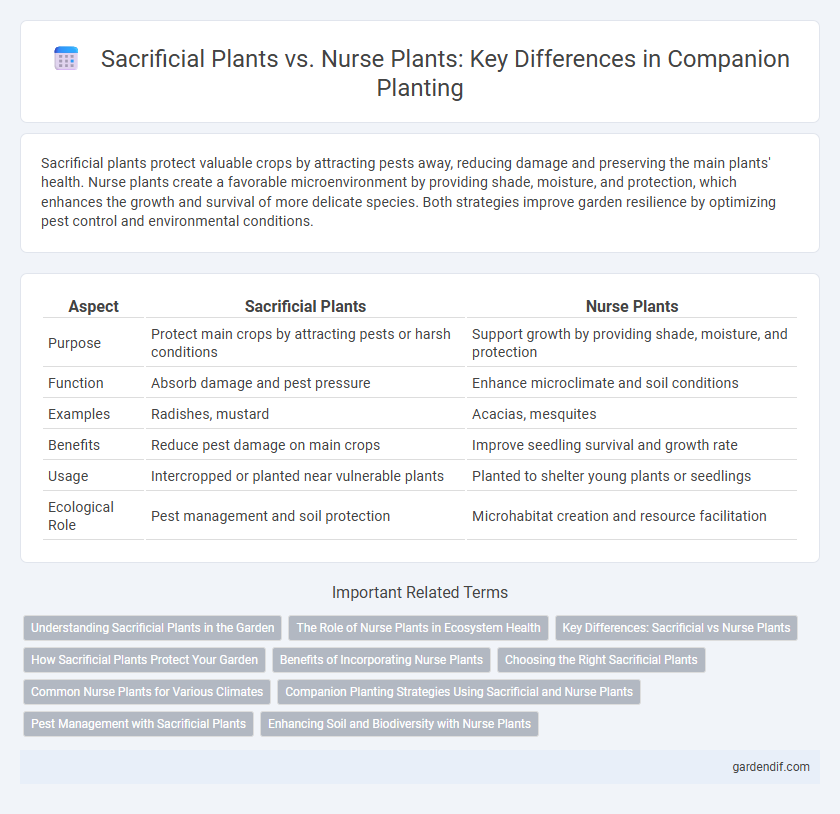
Sacrificial plants vs nurse plants Illustration
Sacrificial plants protect valuable crops by attracting pests away, reducing damage and preserving the main plants' health. Nurse plants create a favorable microenvironment by providing shade, moisture, and protection, which enhances the growth and survival of more delicate species. Both strategies improve garden resilience by optimizing pest control and environmental conditions.
Table of Comparison
| Aspect | Sacrificial Plants | Nurse Plants |
|---|---|---|
| Purpose | Protect main crops by attracting pests or harsh conditions | Support growth by providing shade, moisture, and protection |
| Function | Absorb damage and pest pressure | Enhance microclimate and soil conditions |
| Examples | Radishes, mustard | Acacias, mesquites |
| Benefits | Reduce pest damage on main crops | Improve seedling survival and growth rate |
| Usage | Intercropped or planted near vulnerable plants | Planted to shelter young plants or seedlings |
| Ecological Role | Pest management and soil protection | Microhabitat creation and resource facilitation |
Understanding Sacrificial Plants in the Garden
Sacrificial plants act as decoys, attracting pests away from more valuable crops and reducing overall damage in the garden. By deliberately planting species that pests prefer, gardeners protect main plants without using chemical pesticides. Understanding their role enhances integrated pest management strategies and promotes a healthier, more sustainable garden ecosystem.
The Role of Nurse Plants in Ecosystem Health
Nurse plants play a critical role in ecosystem health by facilitating the growth and survival of sacrificial plants through microclimate amelioration and soil enrichment. These plants enhance biodiversity by creating sheltered environments that reduce stress from extreme temperatures, desiccation, and herbivory, which improves seedling establishment and ecosystem resilience. Their presence supports ecological succession and nutrient cycling, reinforcing the stability and functionality of various habitats.
Key Differences: Sacrificial vs Nurse Plants
Sacrificial plants are intentionally planted to absorb pests, diseases, or environmental stress, protecting the main crops by diverting harm away from them. Nurse plants, on the other hand, provide essential benefits like shade, moisture retention, and improved soil nutrients to support the growth and survival of more vulnerable plant species. The key difference lies in their primary function--sacrificial plants act as protective shields, while nurse plants facilitate healthier development and ecosystem balance.
How Sacrificial Plants Protect Your Garden
Sacrificial plants serve as a protective barrier by attracting pests away from valuable garden crops, reducing damage and preserving plant health. These plants absorb stress from harsh environmental conditions, such as intense sunlight and wind, shielding more vulnerable species beneath them. By enhancing microclimate stability and deterring herbivores, sacrificial plants increase overall garden resilience and productivity.
Benefits of Incorporating Nurse Plants
Nurse plants improve soil quality by enriching organic matter and enhancing moisture retention, which supports the growth of sacrificial plants. They provide shade and protection from harsh environmental conditions, reducing transplant shock and increasing survival rates. Utilizing nurse plants in companion planting enhances biodiversity and promotes a resilient garden ecosystem.
Choosing the Right Sacrificial Plants
Choosing the right sacrificial plants involves selecting species that attract pests away from valuable crops while thriving in the same environmental conditions. Ideal sacrificial plants often have strong pest-repellent properties or act as trap crops to protect nurse plants, enhancing overall garden resilience. Understanding the growth cycles and pest preferences helps optimize the effectiveness of sacrificial plants in companion planting systems.
Common Nurse Plants for Various Climates
Common nurse plants such as mesquite, creosote bush, and palo verde play a vital role in desert ecosystems by providing shade, moisture retention, and protection for young seedlings, promoting biodiversity and plant survival across arid climates. In temperate regions, species like alder and black locust enrich soil nitrogen, enhancing growth conditions for neighboring plants and improving overall vegetation health. Nurse plants act as ecological facilitators, creating microhabitats that buffer temperature extremes and conserve water, making them essential for restoration and sustainable landscaping projects in diverse climatic zones.
Companion Planting Strategies Using Sacrificial and Nurse Plants
Sacrificial plants are strategically planted to attract pests away from valuable crops, minimizing damage and preserving overall plant health in companion planting. Nurse plants provide essential shade, moisture retention, and protection to young or sensitive plants, fostering a microenvironment that enhances growth and survival rates. Combining these companion planting strategies creates a balanced ecosystem that optimizes pest control and supports robust plant development.
Pest Management with Sacrificial Plants
Sacrificial plants play a crucial role in pest management by attracting pests away from valuable crops, reducing the need for chemical pesticides and promoting natural pest control. These plants act as a buffer, drawing insects like aphids and caterpillars, which can help preserve the health of nurse plants by minimizing direct pest damage. Implementing sacrificial plants in companion planting strategies enhances biodiversity and supports integrated pest management systems.
Enhancing Soil and Biodiversity with Nurse Plants
Nurse plants improve soil health by providing shade, moisture retention, and organic matter, which boosts microbial activity and nutrient cycling. They create microhabitats that support diverse plant and animal species, enhancing ecosystem resilience. Unlike sacrificial plants that protect crops by absorbing pest damage, nurse plants actively enrich soil quality and promote long-term biodiversity.
Sacrificial plants vs nurse plants Infographic

 gardendif.com
gardendif.com